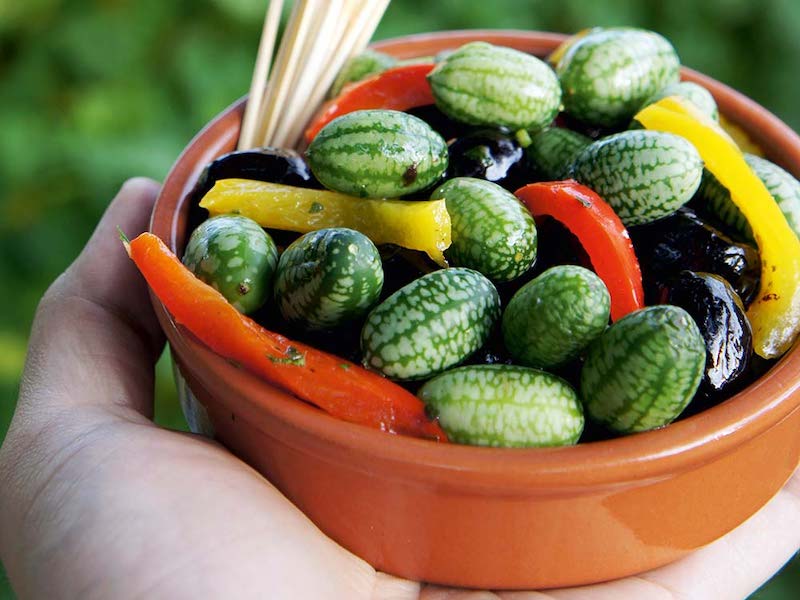If you fancy an unusual twist to summer salads, why not try cucamelons? Originally from South America, they look like miniature melons but taste like a combination of cucumber and lime. This easy-to-grow vine tolerates drought, tends to be ignored by pests and produces masses of grape-sized fruit throughout the summer. Here’s how to sow cucamelon seeds and harvest a bumper crop.
What are cucamelons?
Known in Mexico as ‘Sandiitas de Raton’, or ‘Little Mouse Watermelons’, cucamelons are part of the same family as cucumbers, squashes, courgettes and pumpkins. They’re a cute little fruit with bags of personality which grows in the wild from Mexico to Venezuela and has been harvested by indigenous people since well before the arrival of European settlers. A self-fertilising plant, cucamelons produce small yellow flowers – with female flowers developing a little while before the males. The fruit forms around the base of the female flowers and grows to between 2.5 and 4cm in length.
How and when to sow cucamelon seeds

Cucamelons can be grown from seeds or bought as super plug plants
Image: Cucamelon seeds from Suttons
Sow your cucamelon seeds during April and May. Ideally, you should use a propagator or plant your seeds in the greenhouse where a steady temperature of 22-24ºC (71-75ºF) allows them to germinate in around 10 days. Sow the seed 1 cm deep, with the blunt end facing downwards. When the seedlings are large enough to handle, transfer them into 9cm (3½″) pots to grow on.
Once all danger of frost has passed, it’s fine to plant your cucamelons outdoors. Choose a sunny, sheltered spot and plant them 30-40cm (12-16″) apart, providing canes for support. Alternatively, grow your cucamelon plants to fruition in the greenhouse, in a grow bag, large pot, or in the border. Water and feed your plants regularly with liquid tomato fertiliser.
Once the main shoot has reached a height of 2.5m (8ft), pinch out the growing tip. Pinch out the growing tips of the side shoots when they are 40cm (16″) in length.
The plants will start to fruit in July and continue until late September. Your cucamelons are ready to pick when they’re the size of olives or small grapes and are still firm. Leaving them on the plant longer can result in a slightly bitter flavour and a soggy texture.
Cucamelons can also be treated as a perennial providing you with fruit year-after-year. In late autumn, once the fruiting period is over, lift the cucamelon’s main radish-like root and store in barely moist compost in a garage or shed over winter. Plant out again in early April to achieve early fruiting.
How to enjoy your cucamelons

Cucamelons make a lovely summer aperitif
Image: Cucamelon seeds from Suttons
Use your cucamelons in exactly the same way you would traditional cucumbers – sliced into salads, chopped into salsas or pickled whole like cornichons. Alternatively, mix whole cucamelons (fresh, blanched or pickled) into a bowl of olives and serve with drinks. For a tangy twist on cocktail hour, add them to a gin and tonic or a jug of Pimm’s.
Lead image: Shutterstock
Last Updated on December 3, 2025 by Suttons Horticultural Team





